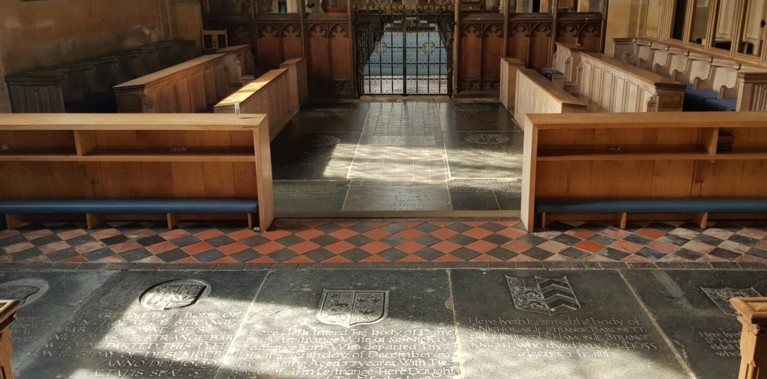Blog
31 July 2024
 L’Estrange family tombstones in the church of St Mary the Virgin, Old Hunstanton
L’Estrange family tombstones in the church of St Mary the Virgin, Old Hunstanton
John Venn’s Alumni Cantabrigienses, the comprehensive listing of all known Cambridge University men, contains the following entry: Roger Lestrange. Matric pens. from Emman. Mich 1601. Son of Sir Nicholas (1580) and Mary Bell. Drowned ‘at Emmanuel’ while at Cambridge. Brother of Hamon (1601). (Blomefield, x. 115). The sensational statement that a student drowned here – presumably in the Paddock pond! – naturally begs investigation, but in fact the entire entry is open to question.
The L’Estrange family, anciently settled at Hunstanton Hall, Norfolk, sent many of its sons to Cambridge. Emmanuel’s admission register contains no record of Roger, though, because for some reason the names of the 1601 entrants were not entered. Coincidentally, the university matriculation books were not maintained during this period, either, due to the laxness of the Registrary, Thomas Smith. The lists of matriculands sent to Smith every year by the praelectors of each college have survived, though, and these record a ‘Roger Straunge’ matriculating from Emmanuel at Michaelmas 1601. His parentage is not stated.
Venn’s identification of this Roger as the son of Sir Nicholas L’Estrange is presumably based on: (1) the fact that the family name was often spelled Straunge or Strange; (2) the perennial popularity of the name ‘Roger’ within the L’Estrange family; (3) information contained in Francis Blomefield’s History of the County of Norfolk, judging by the footnote. On inspection, however, it turns out that the L’Estrange section in that multi-volume tome does not mention Roger; indeed, it represents Sir Nicholas as having only one son: his heir, Hamon, who was admitted to Queens’ College in 1601.
Other nineteenth-century printed histories and pedigrees, however, state that Sir Nicholas had three sons: Roger, Henry, and Hamon, the elder two dying without issue. One source adds that they died during their father’s lifetime, and that Hamon, in consequence, inherited the lordship of Hunstanton from his father upon the latter’s death. This version of events is supported by the usually reliable History of Parliament Online. A problem arises, then, because Sir Nicholas died in December 1591, a decade before Roger was admitted to Emmanuel. Unless the sources are wrong, and Roger and/or Henry were in fact younger brothers of Hamon, the ‘Roger Straunge’ admitted to Emmanuel in 1601 cannot have been the son of Sir Nicholas L’Estrange.
Roger could, of course, have belonged to a cadet branch of the family, but whatever his standing, it is the case that none of the numerous L’Estrange memorials in Old Hunstanton church commemorates him. His dramatic demise is not recorded in Emmanuel’s archives, either. It was not until December 1913, when John Venn sent Emmanuel’s Bursar details of the intriguing entry he was preparing for Roger, that the college became aware of the young man’s existence. The Bursar forwarded the missive to the Master, with a jocular covering note: ‘Venn, supplementing our broken record for 1601, gives one Roger Straunge as admitted to Emmanuel in this year. Shall we drag the pond?’.
Venn’s statement about Roger’s drowning ‘at Emmanuel’ is presented as a quotation, but of what, or whom, has proved impossible to trace. The source’s reliability cannot, therefore, be evaluated. Swimming had been strictly forbidden to Cambridge students by a Heads of House order of 1571, on pain of public whipping and (for a second offence) expulsion. If Roger Straunge voluntarily entered Emmanuel’s pond, then, it was in defiance of this decree. His true fate, like his identity, seems likely to remain a mystery.
Amanda Goode, College Archivist
